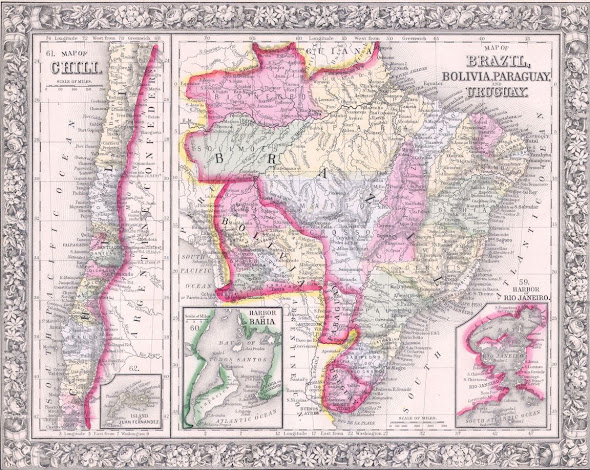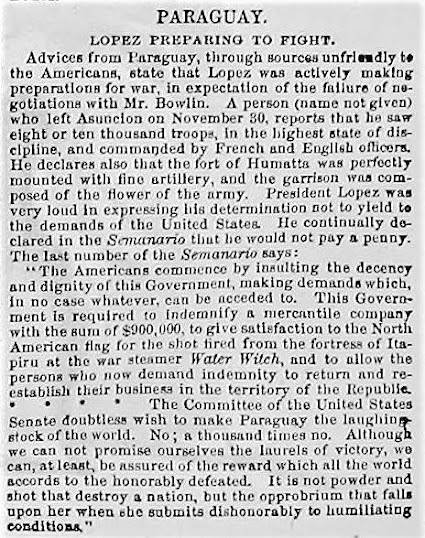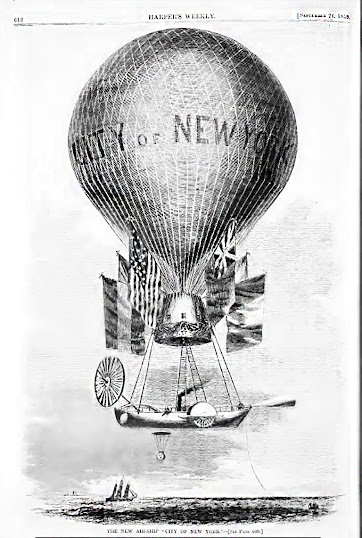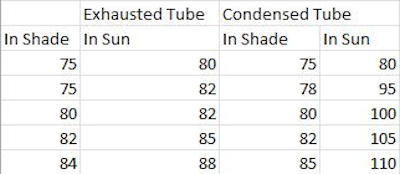1858-America's War With Paraguay
The US War With Paraguay--1858
Yes.
The United States almost went to
war with Paraguay in 1858.
Yeah. That Paraguay. The landlocked
country in the middle of South America, then about the size of Texas.
Congress authorized President
Buchanan “to restore American honor by any means including force if necessary,”
(similar to the Congressional authorization President Lyndon Johnson received
to launch the Vietnam War.) It was a serious operation which sent one
fourth of the US Navy (19 ships) and 2,500 troops to Buenos Aires to await
orders to sail 1,300 miles up the Paraná River for which they had few charts, past
well-armed forts, to invade a country for which they had no maps nor any idea
of the size of enemy forces.
And the President/dictator of
Paraguay, Carlos Antonio Lopez, originally thought he was signing a treaty of goodwill
and trade between the two countries.
If it had not been for cool heads of
an American navy admiral and the accompanying chief diplomat, a Missouri lawyer, America could have had its first quagmire more than a century
earlier than Vietnam.
In the end, US military operations
cost $3.5 million. Paraguay paid $9,600
indemnity.
Here’s how it happened…
In 1845 Edward A. Hopkins, 22, resigned
his commission in the US Navy after his third court martial. He was described
as arrogant, pushy, egomaniacal, aggressive, greedy and a liar.
For some reason Hopkins was
fascinated by South America, Paraguay in particular. He gathered as much
information on the country as he could and then approached President James K.
Polk in 1847 asking for a diplomatic posting to that country. Polk was
interested in establishing diplomatic and trade relations with the new
republics forming after liberation from Spain. He sent Hopkins to see then
Secretary of State James Buchanan along with a note recommending him for a
posting to Paraguay.
Secretary Buchanan had serious
doubts about Hopkins’ suitability—he knew Hopkins reputation and youth-- but the
president had recommended him, and Buchanan certainly could not find anybody
else to go.
It would not be until 1857 that the
US Congress would agree to fund a professional diplomatic corps. Until then consuls
and ambassadors were unpaid, expected to earn money by promoting their own
business interests in places they were stationed. The diplomatic appointments were
based on political patronage, family connections and bribes.
Hopkins had no diplomatic power per
se. He was simply to tour Paraguay
taking notes on their economy and inclinations to open relations and trade with
the United States. Hopkins was to regularly send reports to Washington.
Hopkins did as he was told—and then
some. In his tour, Hopkins befriended the president/dictator of Paraguay Lopez.
Obese, touchy, proud, and sly, President Lopez was eager for trade with the
United States.
Within three months Hopkins’
arrogance and self-confidence got the better of him. He far exceeded his
authority, claiming he had full US authority to mediate disputes between Paraguay
and Juan Manuel Rosas, dictator of Argentina.
When the president of Argentina
declined Hopkins’ offer, the young man wrote him such an insulting letter, that
Secretary Buchanan recalled him and published an official apology to Rosas.
Returning to the US, Hopkins spent
the next several years promoting a get rich quick scheme to wealthy
Americans. Hopkins proposed forming the United States and Paraguay
Navigation
Company which would have a lock on all business between the
two countries. Persuasive and smooth, Hopkins raised $100,000 for the venture,
including a large investment from the governor of Rhode Island. Hopkins was to
accompany the machinery, goods, and money to Paraguay and act as the manager of
operations there. Lopez treated Paraguay
as his private estate and Hopkins believed no enterprise could succeed there
unless protected by some diplomatic status. His investors persuaded the new
Secretary of State William Marcy, to give Hopkins hazy diplomatic status in
Paraguay.
Hopkins set out and got as far as
Montevideo, Uruguay where he learned the ship carrying the company goods and
machinery had sunk off the coast of Brazil. Still, Hopkins pressed on to
Asuncion where he was welcomed by President Lopez along with a $10,000 gift.
Hopkins set up businesses in tobacco and a sawmill. With President Lopez backing,
the businesses prosper. Translation, Lopez provided dirt cheap labor and took a
part of the profits.
As Hopkins set up businesses, Lopez
allowed the US Navy survey vessel Water Witch to map the constantly
shifting shoals and islands of the Paraná and Paraguay Rivers. As wide or wider than the Mississippi, and as
long, the rivers had to be mapped before commercial ships would dare sail as
far upriver as the Paraguayan capital, Asuncion.
Commander of the USS Water Witch was
one Lt. Thomas Jefferson Page. Lopez authorized Page to map the river only a
certain amount further north of Asuncion. A border dispute was brewing between
Paraguay and Brazil (which would lead to war in 1864) and Lopez did not want
Brazil to possibly obtain accurate maps of the area or to set a precedent of
allowing warships on that part of the river.
Lt. Page ignored President Lopez’
license to map no further north than a certain point. Page went a very long ways further.
Shortly before Lt Page and the Water
Witch returned to Asuncion in September 1854, Edward Hopkins spectacularly
insulted President Lopez and was ordered to leave the country. Hopkins’ brother
had been out riding with the wife of the French consul when they encountered Paraguayan
soldiers herding cattle. The corporal in
charge politely asked Hopkins and the lady to move to one side as he feared
their presence might cause a stampede. Hopkins refused, and sure enough, the
cattle stampeded, leaving the soldiers to round them up again. Angry and
frustrated, the corporal whacked Hopkins’ brother across the rump with the flat
of his sword.
On hearing of the incident, Edward
immediately rode to the presidential palace, shoved past guards and aides to
surprise President Lopez and his ministers in a meeting. Swearing loudly in English,
Edward Hopkins brandished a bull whip and threatened to use it on Lopez himself
if there were no apology forth coming. Surprised and astonished, not
understanding a word Hopkins had shouted, Lopez finally got a reasonable
account of the matter. He had the
corporal given 300 lashes. That wasn’t
good enough for Hopkins. He demanded an official apology in print in the
official newspaper.
President Lopez had had enough. There
would be no printed apology. Moreover, he ordered Hopkins to turn over certain
papers (probably business records) and immediately leave Paraguay. That’s when the Water Witch returned,
and Lopez found Lt. Page had mapped far beyond where he should have stopped. Enraged,
Lopez ordered the Water Witch to leave at once. Lt. Page felt he should help a fellow American,
so when the Paraguayans proved obstinate—not providing the paperwork in English
for Hopkins to leave among other things--he pointed the Water Witch’s
three guns at the Presidential palace and took Hopkins on board along with
papers Hopkins was supposed to turn over. The Water Witch then left for
Buenos Aires September 17, 1854.
Outraged, Lopez issued an official
decree forbidding any foreign warships from sailing Paraguayan waters.
In the meantime, the US Senate was
about to vote to accept the trade and relations treaty with Paraguay. The American consul in Buenos Aires--the only
American diplomate in southern South America-- had not proof read the agreement
before sending it on to Washington.
Some pedantic grammar queen noticed
the treaty referred to the United States as “The Union of North America.” It was obvious what was meant, but the treaty
was sent back to have the wording corrected and approved by President Lopez.
Months later, when the treaty finally
made its return to Lopez for his correction and signature, he refused to accept
it since the treaty was not in Spanish.
Back in the US, Hopkins loudly
proclaimed to the public and his investors, that President Lopez had violently
and greedily expropriated American property and then banned warships to prevent
retaliation and then refused to sign a trade and goodwill treaty. Hopkins’ backers were men with influence so
political wheels began to grind with a lawsuit to force compensation,
compensation far in excess of the $100,000 they had invested.
Things got worse.
Lt. Page anchored and re supplied the
Water Witch at the Argentinian river port Corrientes in
January, 1855. Corrientes lay a few miles from the Paraguayan border. Lopez
sent his son to see Lt. Page on the Water Witch. President Lopez still
wanted a trade treaty and recognition of his government from the United States.
Lt. Page and the president’s son’s
meeting was cordial. Lt. Page presumed relations
were patched up and all forgiven. The
next day, January 20, 1855, Page left along with 19 of his men on a planned
expedition to explore the Salada River. That same morning, Page put Lt. William
N. Jeffers in command of the Water Witch, ordering Jeffers to
steam north into Paraguay and re map the northern Paraná River.
By any standards, the Paraguayan Fort
Itapuri commanding the river at the border was formidable. Well-fortified heavy guns and several
thousand troops stood guard. Itapuri’s commander had received no word
the policy forbidding warships on the Paraguayan stretch of the Paraná had been
changed. (And it hadn’t been!) When the Water
Witch appeared there was some confusion. The ship was known to be a non-combatant
survey vessel but still…
Jeffers steamed on.
The next volley was in earnest,
ripping away much of the Water Witch’s rigging and shattering the pilot
house. Helmsman Samuel Chaney lay dying in the wreckage.
The ship’s puny weapons returned fire
as the vessel passed, finally steaming beyond the range of the fort’s guns.
Then Jeffers realized he was not safe for long.
He’d brought the ship into shallow water. There was only a foot between
his keel and the river bottom. The Water Witch could easily run aground
and be overrun by the Paraguayan army. The
only way out was to steam backwards along the way they came, past the fort once
more.
The fort’s gunners were skilled. Ten of their twelve shots damaged the hull of
the Water Witch as well as disabling one of its side paddle wheels. The
Paraguayan cruiser Tacuara appeared while Jeffers was desperately
repairing his ship. Jeffers seriously
considered engaging the Tacuara. He decided against it quickly. A lightly armed survey ship, partly disabled
and sinking, was no match for a fully armed cruiser. Lt. Jeffers barely managed to get the Water
Witch back over the border and escape capture.
When Lt. Page heard what had
happened, he angrily demanded (four times in two months,) the Navy provide a
heavily armed squadron to come destroy the fort “to teach a lesson and restore
the flag’s honor.”
Wisely, the US Admiral commanding
the meager American forces in the area refused him.
That was the end of it for several
years.
Newly elected, President James Buchanan
made his first address to Congress in December 1857. For some reason—perhaps,
because Hopkins’ backers were pressuring him, or perhaps because he thought a
foreign war would unite a country rapidly coming apart--Buchanan revived past
incidents with Paraguay nearly four years after the fact. Calling Fort Itapuri’s firing on the Water
Witch “a most unprovoked, unwarrantable, and dastardly attack,” Buchanan
went on: Paraguay had: seized and appropriated the property of American citizens
residing in Paraguay in a violent and arbitrary manner; upon frivolous and even
insulting pretexts, refused to ratify the treaty of commerce and free
navigation; and fired on the United States steamer Water Witch…and killed the
sailor at the helm, Samuel Chaney, while the ship was peacefully surveying the Paraná River.
Buchanan asked Congress to
authorize him “to restore American honor” even if he had to use force.
In
June 1858, Congress voted all the funds necessary to obtain satisfaction for American
honor, using force if necessary, including appointing civilian agents to
purchase suitable merchant steamships to be converted into war vessels for the
US Navy.
NY Herald Dec 9, 1858
The US Navy to Lease Ships
Below: NY Times publishes Lopez defiance February 1859
Buchanan
promised Congress a diplomatic approach would be attempted first. A lawyer, James Bowlin, former Post Master
General (and the man who had introduced postage stamps ten years earlier) was
chosen as representative and negotiator. Bowlin was to obtain ratification of the trade
treaty; negotiate no less than a half million dollars’ compensation for Hopkins
and his investors; obtain an apology for rudeness shown US Naval officers when
presenting the treaty; and at least $5,000 for the family of the dead helmsman,
Samuel Chaney.
Several months later, 19 ships carrying a total of 200 guns,
one fourth of the US Navy, “the Paraguay Squadron,” along with 2, 500 fighting
men steamed toward Montevideo, Uruguay. If no agreement with Paraguay were
reached, Shubrick was to sail 1,300 miles up the Parana river and bombard Asuncion
to rubble.
Shubrick’s force arrived in Montevideo, in December 1858.
The Paraguay Squadron--Harper's Magazine December 1858
Ambassador
James Bowlin reassured Uruguay and other nations the expedition was there on a
peaceful mission. In January, the US Navy started up the Paraná river. Ships with deeper drafts were left along the
way at several Argentine ports. Bowlin and Admiral Shubrick continued into
Paraguay with only one ship, the USS Fulton. Bowlin intended entering
Paraguay in a single ship to signal peaceful intentions. Lopez recognized that
and received Bowlin and the Admiral with great courtesy.
It
did not take long for Admiral Shubrick and James Bowlin to recognize true fault
lay with Hopkins, Lt. Page, and Lt. Jeffers. They recognized as well that the
incompetence of the American consul in Buenos Aires was a contributing factor.
Soon,
Lopez signed the trade treaty with the United States, opened Paraguayan waters
to American merchant ships, and promised a cash payment of $9,600 to Samuel Chaney’s
family.
But
Bowlin still had a problem. The final
issue was the matter of paying compensation to Hopkins’ investors. Buchanan had strictly instructed him to
accept no less than $500,000 from Paraguay to be paid to Hopkins’ investors. Neither Bowlin nor Shubrick believed the
investors were owed a dime given Hopkins’ outrageous behavior and the insane
demand for $900,000 in damages for an investment of only $100,000.
Bowlin
urged Lopez to agree to an arbitration commission, sure Lopez would win when
the facts came to light. Moreover, Admiral Shubrick recommended a friend, a good
lawyer licensed to argue cases before the US Supreme Court.
Sam
Howe, brother of Julia Ward Howe, was present as translator between Lopez and
Bowlin. Howe was nominated to be secretary
to the arbitration committee. Howe was a
bon vivant and later became known as a leading congressional
lobbyist. Lopez bribed Howe with a lump
sum to get the trade treaty passed correctly by the US Senate. Further, Lopez promised
Howe a commission of 2% of the amount below $500,000 the arbitration committee
decided.
The
arbitration committee was formed in mid-1859 but its final ruling was not
announced until August 1860. When it
came, it was no surprise. Hopkins’
investors were awarded nothing.
Assessing
costs and lessons from the expedition, the US Navy found the merchant vessels
leased were barely seaworthy to begin with and once converted not much
improved. A Congressional investigation
concluded it had been a corrupt way to award patronage to political allies.
Had it come to war, Adm. Shubrick had only seven hours’
worth of ammunition for his guns, and 2,500 men were far too few to defeat the
Paraguayan Army. Adm. Shubrick could
have blockaded the river, but Paraguay was poor enough it was self-sufficient.
A blockade would have little effect and to maintain such a blockade would have
forced American forces to rely on a supply line stretching over several
thousand miles back to the Eastern United States. Plus maintaining 2,500 troops
in South America would not be popular or worthwhile. (Keep in mind,
the total size of the US Army was 16,500 men and officers; 5,000 men were
engaged in the Mormon War in Utah, 2,000 more were keeping order in “Bleeding
Kansas, and the rest scattered over the newly conquered West fighting Indians
whenever White settlers broke treaties.
It’s little wonder that when South Carolina seceded in 1860, one of
Charleston’s forts was manned solely by an elderly sergeant, his wife and
kids.)
Not
only did the advent of the American Civil War make most of the treaty moot, but
Paraguay stumbled into disaster in 1864.
In 1862 President Lopez died. His son, Francisco, became president and border disputes with Brazil, Argentina, along with Francisco Lopez’ meddling in the Uruguayan Civil War, plunged the country headlong into what came to be called the Triple Alliance War. The Paraguayans fought fanatically, and it took six years to defeat Lopez’ army. In the end, Paraguay lost much of its territory and demographers have argued between 69% and 18% of Paraguay’s population died. One census after the war found a ratio of four women for every man and an even higher female to male ratio in some areas.
Harper's Magazine 1859
Afterwards---Lt. Thomas Jefferson Page left the US Navy when his home state, Virginia, seceded . For a while he was a colonel of artillery. In 1863, he was put into the Confederate Navy and sent to Europe to oversee construction of and command of the ironclad ram CSS Stonewall. His ironclad arrived in American waters too late to take part in the war, so he sailed for Havana and turned over his ship to Spanish authorities.
From Havana he went to Argentina where he helped found a colony of ex Confederates; became an adviser to the Argentinian navy and finally was sent to Italy as secretary to the Argentinian ambassador. He lived in Rome until his death in 1899.
Lt. William N Jeffers stayed in the US Navy. He commanded several ships, one of which took part in the invasion of eastern NC. Afterwards, he was briefly commander of the ironclad Monitor. In 1863, he was made US Navy inspector of ordinance. He continued in the navy after the war, commanding a frigate in the Mediterranean. He spent the final eight years of his service a chief of the Ordinance Bureau until his death in 1888. Before Paraguay, Jeffers had done a survey of Honduras. He took part in three naval bombardments of Mexican forts in the Mexican War. This experience probably caused his reaction to the Fort of Itapuri opening gun ports and running out guns.
Edward A. Hopkins continued roaming about South America when he wasn't in the United States pursuing his claims in courts. His final appeal was thrown out in the 1880s.
Commodore (later Admiral) William B. Shubick--remained loyal to the Union despite being a son of a wealthy South Carolina planter. He had served in both the War of 1812 and the Mexican War. Soon after the beginning of the Civil War he was promoted Admiral and forced to retire on account of his age in 1861 (70 years old) . He died in Washington DC in 1874.
James B. Bowlin was almost 30 when he left his native Virginia and moved to St. Louis. Diving into politics, it did not take him long to win Missouri's sole congressional seat in which he served several terms before a three year stint as ambassador to Columbia. After his service in Paraguay, he returned to his law practice in Missouri. He died there in 1874.
Some more original sources may be found at
The Water Witch Incident by Clare McKenna
Lt. Page's account of encounters and explorations in South America















Reminds me of the William Walker affair in Nicaragua...
ReplyDelete